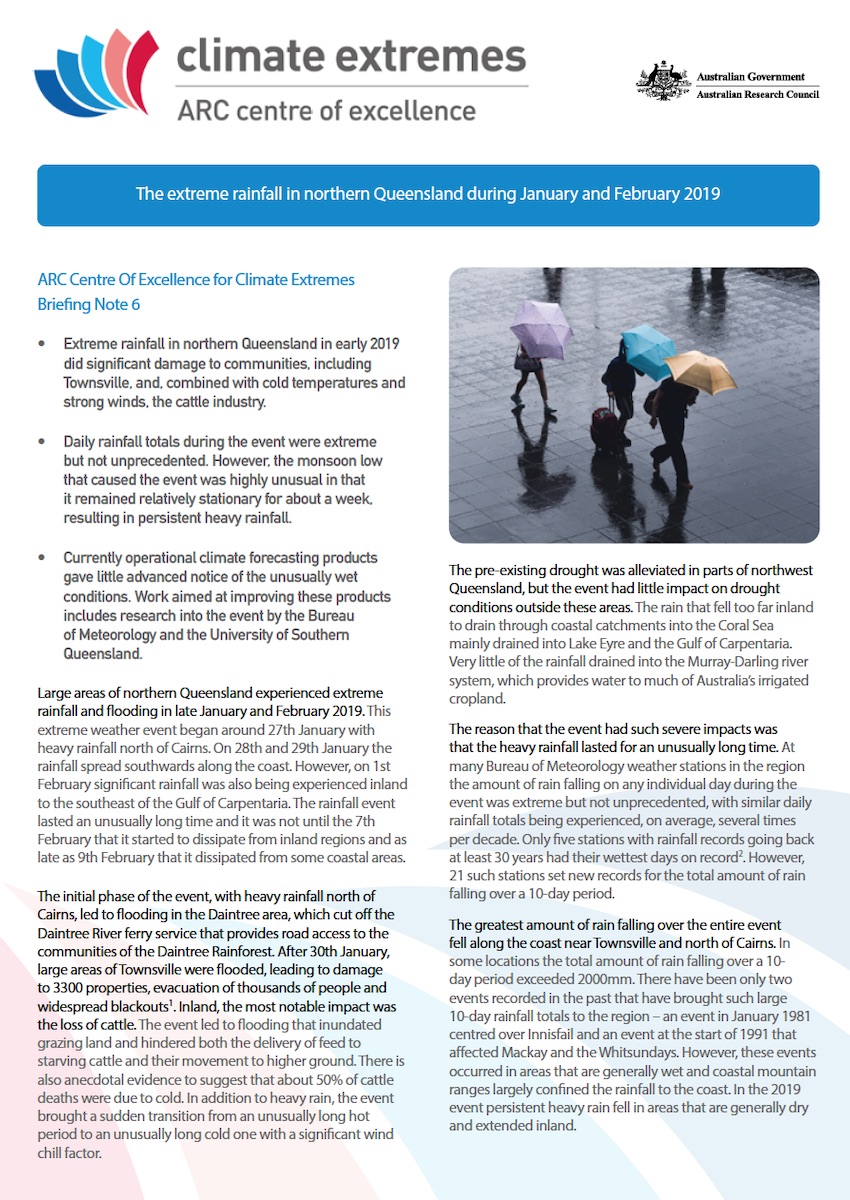Key Points
- Extreme rainfall in northern Queensland in early 2019 did significant damage to communities, including Townsville, and, combined with cold temperatures and strong winds, the cattle industry.
- Daily rainfall totals during the event were extreme, but not unprecedented. However, the monsoon low that caused the event was highly unusual in that it remained relatively stationary for about a week, resulting in persistent heavy rainfall.
- Currently operational climate forecasting products gave little advanced notice of the unusually wet conditions. Work aimed at improving the forecast products includes research into the event by the Bureau of Meteorology and the University of Southern Queensland.
Large areas of northern Queensland experienced extreme rainfall and flooding in late January and February 2019. This extreme weather event began around January 27 with heavy rainfall north of Cairns. On January 28/29 the rainfall spread southwards, though was mainly confined to the coast. However, on February 1 significant rainfall was also being experienced inland to the southeast of the Gulf of Carpentaria. The rainfall event lasted an unusually long time and it was not until February 7 that it started to dissipate from inland regions and as late as February 9 that it dissipated from some coastal areas.
The initial phase of the event, with heavy rainfall north of Cairns, led to flooding in the Daintree area, which cut off the Daintree River ferry service that provides road access to the communities of the Daintree Rainforest. After January 30, large areas of Townsville were flooded, leading to damage to 3300 properties, evacuation of thousands of people and widespread blackouts1. Inland, the most notable impact was the loss of cattle. The event led to flooding that inundated grazing land and hindered both the delivery of feed to starving cattle and their movement to higher ground. There is also anecdotal evidence to suggest that about 50% of cattle deaths were due to cold. In addition to heavy rain, the event brought a sudden transition from an unusually long hot period to an unusually long cold one with a significant wind chill factor.
The pre-existing drought was alleviated in parts of northwest Queensland, but the event had little impact on drought conditions outside these areas. The rain that fell too far inland to drain through coastal catchments into the Coral Sea mainly drained into Lake Eyre and the Gulf of Carpentaria. Very little of the rainfall drained into the Murray-Darling river system, which provides water to much of Australia’s irrigated cropland.
The reason that the event had such severe impacts was that the heavy rainfall lasted for an unusually long time. At many Bureau of Meteorology weather stations in the region the amount of rain falling on any individual day during the event was extreme but not unprecedented, with similar daily rainfall totals being experienced, on average, several times per decade. Only five stations with rainfall records going back at least 30 years had their wettest days on record2. However, 21 such stations set new records for the total amount of rain falling over a 10-day period.
The greatest amount of rain falling over the entire event fell along the coast near Townsville and north of Cairns. In some locations the total amount of rain falling over a 10-day period exceeded 2000mm. There have been only two events recorded in the past that have brought such large 10-day rainfall totals to the region – an event in January 1981 centred over Innisfail and an event at the start of 1991 that affected Mackay and the Whitsundays. However, these events occurred in areas that are generally wet and coastal mountain ranges largely confined the rainfall to the coast. In the 2019 event persistent heavy rain fell in areas that are generally dry and extended inland.
Extreme rainfall and flooding in northern Queensland is often associated with tropical cyclones. However, the 2019 event was caused by an area of low atmospheric pressure called a “monsoon low”. Heavy rainfall in Queensland resulting from a passing monsoon low is not unusual. Typically, monsoon lows move out of the area relatively quickly, so this rainfall does not last long. However, this low moved across the region unusually slowly and so the rainfall associated with it was unusually persistent.
As late as January 31 our existing operational climate forecasting products gave little indication that February 2019 would be unusually wet in northern Queensland. The extreme rainfall did huge damage and some affected communities would likely have benefitted from a confident forecast well before this. For example, to have taken action to limit damage to their herds, graziers would have benefitted from a confident forecast a week or two in advance.
In their efforts to improve our forecasts, scientists at the Bureau of Meteorology and the University of Southern Queensland have been examining the event in detail. One avenue of investigation has been the effect of the different “large-scale drivers” of the Australian climate. These typically take the form of transient features of the climate of Australia and the surrounding oceans that have a strong effect on winds, temperature and rainfall for parts of the country. The El Niño Southern Oscillation (ENSO) is just one example of the many drivers that affect the Australian climate. There are a great many others (e.g. the Indian Ocean Dipole, the Madden Julian Oscillation the Southern Annular Mode)3, which makes the Australian climate particularly complex. Initial work has found no simple link between the individual drivers and the extreme rainfall event but investigations are ongoinga.
Explainers
References
- Gissing, O’Brien, Hussein, Evans and Mortlock (2019) Townsville 2019 flood – insights from the field. Risk Frontiers Briefing Note 389. https://riskfrontiers.com/rf2018/wpcontent/uploads/2019/03/Briefing-Note-389.pdf
- Bureau of Meteorology (2019) Special Climate Statement 69—an extended period of heavy rainfall and flooding in tropical Queensland. http://www.bom.gov.au/climate/current/statements/scs69.pdf
- Risbey, Pook, McIntosh, Wheeler and Hendon (2009) On the remote drivers of rainfall variability in Australia. Monthly Weather Review. https://doi.org/10.1175/2009MWR2861.1

